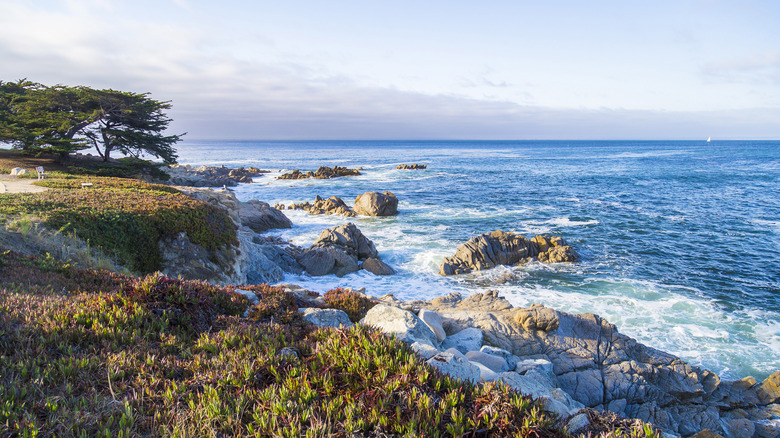Dangerous 'Valley Fever' Is Rising In California, Particularly At This Upscale Coastal Vacation Destination
Infections during travel are always a risk, especially in tourist hot spots and tropical climates. Common fungal infections like swimmers' foot can be picked up just by walking barefoot around a hotel pool while warm-water spots like Florida can expose vacationers to flesh-eating bacteria. And now, in 2025, even the most peaceful West Coast getaways may be putting travelers at risk of contracting the notorious "valley fever," or "cocci," a lung infection caused by inhaling spores of the Coccidioides fungus that lives in the soil of California's fertile central counties — including the luxurious coastal community of Monterey.
While Monterey is far from where valley fever originated, the spores travel via dust particles and can survive dormant in them throughout a drought, spreading farther and wider the dryer it is. Increased construction and agricultural activity to serve a rising population adds to the disturbance. The resulting spread means higher numbers of valley fever infections in rainy years following a dry period. Due to climate change, California has experienced more dramatic shifts in weather for the past 25 years, and valley fever cases are on the rise, spreading wherever the wind may take them — from the valleys to the coast. While fewer than 1,000 cases were reported to the U.S. Centers for Disease Control and Prevention (CDC) statewide in 2000, that number has risen to nearly 12,500 in 2024. And 2025's numbers seem on track to exceed last year's cases.
Along with inland counties where most of California's crops are grown, coastal communities are now getting hit, with Monterey becoming the latest major hotspot in 2024 according to a report by the California Department of Public Health. That means even elite escapes to Pebble Beach are no longer safe, since even the highest grade security can't keep out these unwanted visitors.
What residents and visitors in Monterey should know
While not everyone who breathes in cocci spores will develop valley fever, those who do can experience a combination of symptoms, including coughing, labored breathing, fever, and lethargy. In rare cases, the infection may spread to other parts of the body, causing symptoms as wide-ranging as skin lesions, aching joints, paralysis, vision impairment, and heart failure. While numbers of reported cases have risen, yearly hospitalizations remain less than 1,000, with about 100 resulting in death. However, the CDC warns that symptomatic cases are typically underdiagnosed and under-reported (it estimates an actual 200,000 to 360,000 cases per year for the 20,000 reported, nation-wide — not just in California).
Valley fever is thankfully non-communicable, so you won't catch it from your neighbor. (But you could catch it from the dirt blowing off your neighbor's car if they've been driving through a dust cloud in an affected region — such as, say, Monterey.) Symptoms can take three to four weeks to develop and tend to get reported in the autumn and early winter, so for personal protection, it makes sense to avoid contaminated regions during the dry summer and early autumn months. Those most at risk include people living or working in agricultural and construction areas, seniors, immunocompromised individuals, pregnant people, and diabetics.
If you or someone you know is passing through Monterey, remain vigilant to flu-like symptoms as diverse as difficulty breathing, fatigue, or unexplained weight loss, and consider getting tested for valley fever if experiencing any of these symptoms. As a preventative measure, you can wear a face mask that covers your nose and mouth while in the vicinity, and avoid going outdoors or driving with the windows rolled down (yes, even on the famous 17-Mile Drive in Pebble Beach, one of the world's most scenic coastal routes).

